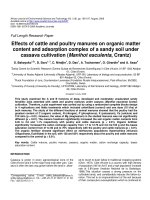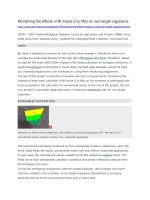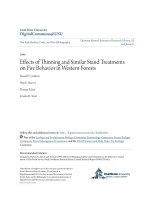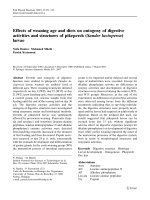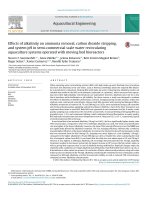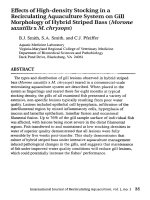Effects of ascorbic acid as antioxidant semen additive in cryopreservation of cross-bred cattle bull semen
Bạn đang xem bản rút gọn của tài liệu. Xem và tải ngay bản đầy đủ của tài liệu tại đây (266.4 KB, 11 trang )
Int.J.Curr.Microbiol.App.Sci (2020) 9(7): 3089-3099
International Journal of Current Microbiology and Applied Sciences
ISSN: 2319-7706 Volume 9 Number 7 (2020)
Journal homepage:
Original Research Article
/>
Effects of Ascorbic Acid as Antioxidant Semen Additive in
Cryopreservation of Cross-bred Cattle Bull Semen
Padamveer Singh1, Sanjay Agarwal1*, Harjyote Singh1, Satbir Singh2,
Pawan Kumar Verma3, Mohd Shaheem Butt1 and Utsav Sharma1
1
Divison of Veterinary Gynaecology & Obstetrics, F.V.Sc. & A.H., S.K.U.A.S.T.-J., R. S.
Pura-181102, Jammu, India
2
Frozen Semen Laboratory, U.T. of Jammu & Kashmir, Hukkal, Jammu, India
3
Division of Veterinary Pharmacology and Toxicology, F.V.Sc. & A.H., S.K.U.A.S.T.-J., R. S.
Pura-181102, Jammu, India
*Corresponding author
ABSTRACT
Keywords
Semen, Cattle bull,
Ascorbic acid,
Oxidative stress
Article Info
Accepted:
22 June 2020
Available Online:
10 July 2020
The present study was jointly undertaken at the Frozen Semen Laboratory, U.T. of Jammu
& Kashmir, Hukkal, Jammu and Division of V.G.O., F.V.Sc & A.H., SKUAST- J,
R.S.Pura, during the period between December 2017 and May 2018. This investigation
was carried out with the objective to study the effect of antioxidant semen additive
ascorbic acid on cryopreservation of semen. Semen samples (n=10) from mature cattle bull
stationed at Frozen semen laboratory, U.T. of Jammu & Kashmir, Hukkal, Jammu, were
used to evaluate the effect of ascorbic acid additive at post-dilution and at post thaw stage.
The semen sample was extended with Tris-Egg-Yolk-Citric-acid-Fructose-Glycerol
(TEYCAFG) extender and were split into two groups: Group 1: TEYCAFG without any
additive/ control and group 2: TEYCAFG + Ascorbic acid (5mM). Progressive motility,
live spermatozoa, acrosomal integrity, sperm abnormality, hypo-osmotic swelling test
(HOST) was evaluated at both post-dilution and post-thaw stage. Whereas, oxidative stress
tests viz. malondialdehyde (MDA), catalase (CAT) and superoxide dismutase (SOD) were
evaluated at only post-thawed stage. Group 2 i.e. ascorbic acid group, showed significant
(p<0.05) increased live spermatozoa, acrosomal integrity and HOST positive spermatozoa,
while significant (p<0.05) decreased sperm abnormalities in post-thawed semen. In
oxidative stress evaluation the MDA level was significantly (p<0.05) decreased, whereas,
SOD levels significantly (p<0.05) increased in group 2 in comparison to control group. It
was concluded that addition of ascorbic acid (5 mM) as semen additive improves semen
quality and minimize oxidative stress to the spermatozoa during cryopreservation of
semen.
Introduction
The milk production in India was 187.7
Million Tonnes (MT) in year of 2018-19
(NDDB, 2020) in which contribution of
Jammu and Kashmir (J&K) is 254 MT. The
cattle population in the country as per 2019
census were 192.5 million out of total bovine
3089
Int.J.Curr.Microbiol.App.Sci (2020) 9(7): 3089-3099
population (302.3 millions) in J&K total cattle
including cross-bred and indigenous were
1231 (in thousands). To meet the objective of
sustainable milk production, special attention
is required for improving the gene pool of the
animals. The best proven way to improve
gene pool is artificial insemination of the
animals with frozen semen from superior
bulls, thus it is only possible by making
available sufficient number of frozen doses
from superior bulls.
Now-a-days the bulls frozen semen has been
widely used in artificial insemination (AI) but
the results of conception is about 50 per cent.
This might be due to freezing and thawing
processes that leads to the generation of
reactive oxygen substances (ROS) that impair
post-thaw motility, viability, intracellular
enzymatic activity, fertility and sperm
functions (Aitken et al., 1998; Zhao and Buhr,
1995; White, 1993).
Oxidative stress is defined as a disturbance in
the balance between the production of
reactive oxygen species (ROS) and
antioxidant defenses in the body. The cause of
oxidative stress is considered as a major
conducive factor to male infertility and
decreased semen quality during the
preservation process (Betteridge, 2000).
Oxidative Stress installed at the level of
tissues, organs or organelles is derived from
the imbalance between the production and
elimination of reactive oxygen species.
Spermatozoa and seminal plasma possess an
antioxidant system comprising taurine,
reduced glutathione (GSH), glutathione
peroxidase (GSH-Px), catalase (CAT), and
superoxide dismutase (SOD) to prevent
oxidative damage. However, this anti-oxidant
capacity in sperm cells, due to the small
cytoplasmic component that contains antioxidants to scavenge oxidants, is limited
(Lapointe and Bilodeau, 2003; Aurich et al.,
1997; Storey, 1997). Addition of antioxidants
to the freezing media like ascorbic acid,
catalase, caffeine, glutathione, taurine etc. in
semen diluent prevent the damage induced by
free radicals to spermatozoa during freezing
as well as improves the fertility of the semen
(Agarwal et al., 2004).
Ascorbic acid or Vit C concentration in
seminal plasma exceeds 10 times more than
that in blood plasma (364 compared with 40
μmol/L) (Tariq et al., 2015). It is an
antioxidant substance, which is normally
present in the epididymal fluid and seminal
plasma of several species (Chinoy, 1972)
which protects sperm from Reactive Oxygen
Species (Buettner, 1993). Vit.C or ascorbic
acid specifically reduces oxygen radicals,
neutralizes ROS and regenerates other
antioxidants system and helps in maintaining
the genetic integrity of sperm cells by
preventing oxidative damage to sperm DNA
(Fragae et al., 1991).
Though few research using ascorbic acid as
an semen additive has been previously
reported but differences exists among
ascorbic acid concentrations used, species,
breed, dilutor composition, freezing method
etc. but such research in the cross-bred bull
semen of Jammu and Kashmir region is
completely missing.
Thus keeping in view the aforesaid facts the
present study was designed with the objective
to evaluate the oxidative stress to the
spermatozoa during cryopreservation of
semen and the effects of ascorbic acid as
semen additive.
Materials and Methods
The present study was jointly undertaken at
the Frozen semen laboratory, U.T. of Jammu
& Kashmir, Hukkal, Jammu and Division of
V.G.O., F.V.Sc & A.H., SKUAST- J,
R.S.Pura, during the period between
3090
Int.J.Curr.Microbiol.App.Sci (2020) 9(7): 3089-3099
December 2017 and May 2018. Semen
samples (n=10) were collected randomly from
mature cattle bull stationed at Frozen semen
laboratory, U.T. of Jammu & Kashmir,
Hukkal, Jammu, India (32.73º N, 74.87º E,
altitude 300 m). Semen was collected twice a
week from each bull by artificial vagina
method. The semen ejaculates were initially
evaluated for volume, mass activity,
spermatozoa concentration and progressive
motility. The ejaculates qualifying the
minimum initial standards were further
processed. After initial assessment of semen,
the selected samples were extended with prewarmed (37°C) Tris egg yolk citric acid
fructose glycerol (TEYCAFG) extender so
that each ml of extended semen contained at
least 40 x 106 spermatozoa (Anel et al., 2003).
After extension, the semen samples were
divided into two parts. The first part was
considered as group 1: TEYCAFG without
any additive/ control and group 2: TEYCAFG
+ Ascorbic acid (5mM). The pH was adjusted
within the range 7.2 to 7.4. The semen
samples were filled in 0.5 ml capacity,
polyvinyl straw (IMV, France). Equilibration
was done in the cold handling unit maintained
at 4° C for 4 hours. Freezing of the straws was
done by programmable biofreezer (Digit
Cool-530, IMV Technologies, France) with
rate freezing from 4°C to -10°C @ 5°C, 10°C to -100°C @ 40°C, -100°C to -140°C @
20°C, after attainment of -140°C temperature
the straws were removed from the racks
shifted to the pre-cooled goblets and plunged
into liquid nitrogen and finally stored in liquid
nitrogen tank where they were stored for
definite period of time for future evaluation.
Total ejaculates (n=10) were evaluated at two
stages of the semen processing viz. postdilution and post thaw stage, for per cent
progressive motility, live spermatozoa,
acrosomal integrity, sperm abnormalities and
hypo-osmotic swelling test. Whereas, only at
post-thaw stage for oxidative stress test viz.
MDA, SOD and Catalase. Thawing of frozen
semen was done at 37° C for 30 seconds.
Volume was measured by graduated
collecting tube, mass activity was graded as
described by Tomar et al., (1966). The
concentration
of
the
spermatozoa
(millions/ml) was determined by Accucell
photometer (IMV Technologies, France).
Progressive motility, live spermatozoa and
acrosome integrity were assessed as per
Salisbury et al., (1978); HOST test was
performed as described by Jeyendran et al.,
(1984); sperm abnormalities were assessed by
Eosin-nigrosin stain with slight modification
as described by Kumar (1993). Oxidative
stress test viz. Malondialdehyde (MDA) was
determined as described by Shafiq-urRehman (1984); Catalase as per Aebi (1983)
and Superoxide dismutase (SOD) as described
by Marklund and Marklund (1974). The
results were analysed statistically using
Analysis of Variance (ANOVA) (Snedecor
and Cochran, 1989).
Results and Discussion
Progressive motility
The per cent progressive motility (Mean ±
SE) post-dilution and post-thawing in control
group were 67.0 ± 1.52 and 48.0 ± 2.49;
whereas in ascorbic acid group were 68.0 ±
1.33 and 50.0 ± 2.11, respectively (Table 1.0).
Perusal of the table (1.0) it was observed that
the progressive motility (%) differed none
significantly between post-diluted control and
ascorbic acid group as well as post-thaw
control and ascorbic acid group.
In the present study in control group the per
cent progressive motility of diluted semen
(Table 1.0) was 67.0 ±1.52 which was in
agreement with the finding of Pathak et al.,
(1990) who reported per cent progressive
motility as 65.30 ± 1.20 per cent in diluted
3091
Int.J.Curr.Microbiol.App.Sci (2020) 9(7): 3089-3099
semen of cattle bull. Whereas, in the control
group per cent post thaw motility (Table 1.0)
was in intermediate range in comparison to
previous reports, which was less than reported
by Kishore, 2009 (80.74); Pawshe et al.,2016
(61.7 ± 2.6); Uysal et al., 2007 (55.5 ± 2.5)
and Ulfina and Raina, 2003 (55.34 ± 1.02),
while it was higher than reported by Hu et al.,
2010 (36.88 ± 1.53) and Li et al., 2016 (14.7
± 1.4).
The main reason for the decrease in the per
cent post thaw progressive motility might be
due to cryopreservation damage, ROS
production and damage caused due to
formation of ice crystal formation in
mitochondria
and
Axomemes
during
cryopreservation that impairs sperm motility.
In the present study in ascorbic acid group the
values of per cent progressive motility of
diluted semen (Table 1.0) was 68.0 ± 1.33,
which was in agreement with the finding of
Mittal et al., (2014) who reported as 66.59 ±
0.99, while it was lesser than as reported by
Rao et al., 2017 (78.05 ± 0.02) and Sandeep
et al., 2015 (73.33 ± 1.07). Whereas, per cent
progressive motility of post thaw semen
(Table 1.0) was 50.0 ± 2.11, which was
higher than as reported by Rao et al., 2017
(46.83 ± 0.01) and Sandeep et al., 2015
(45.62 ± 0.69) and lower than the finding of
Sohail et al., 2015 (62.73 ± 2.80) and Mittal
et al., 2014 (56.75 ± 0.75).
Live spermatozoa
The per cent live spermatozoa (Mean ± SE)
post-dilution and post-thawing in control
group were 74.4 ± 1.82 and 50.8 ± 1.17;
whereas in ascorbic acid group were 72.4
±1.69 and 55.4 ± 0.88, respectively (Table
1.0). Perusal of the table (1.0) it was observed
that the live spermatozoa (%) differed non
significantly between post-diluted control and
ascorbic acid group, whereas, in post-thaw a
significant (p<0.05) difference in live
spermatozoa was observed between control
and ascorbic acid group.
In the present study in the control group
values of per cent live spermatozoa in diluted
semen (Table 1.0) was 74.4 ± 1.82, which
was in agreement with the findings of
Keshava (1996) who reported 74.28 and
Abdul-khalek et al., (2008) as 73.0 ± 1.3.
Whereas per cent live spermatozoa in post
thaw semen (Table 1.0) was 50.8 ± 1.17
which was less than reported by Bhalde et
al.,1991 (57.64 ± 0.78), Rao et al., 2017
(56.24 ± 0.01) and Abdul-khalek et al., 2008
(66-73 per cent). Decreasing proportion of
live spermatozoa in post thaw semen may be
due to cryo-damage caused to formation of
ice crystals in extra and intracellular
environment, increasing solute concentration
(Mazur, 1984) and sperm susceptibility for
freezing and thawing temperature, ROS
production and lipid peroxidation (Bucak et
al., 2008)
In the present study in ascorbic acid group the
value of per cent live spermatozoa of diluted
semen was 72.4 ± 1.69 which was in
agreement with the findings of Sandeep et al.,
2015 (76.21 ± 1.01). Whereas per cent live
spermatozoa in post thaw semen (Table 1.0)
was 55.4 ± 0.88 which was higher than the
findings of Rao et al., 2017 (51.92 ± 0.02)
and Sandeep et al., 2015 (48.21 ± 0.75), while
lesser than the finding of Sohail et al., 2015
(60.43 ± 3.17).
Acrosomal integrity
The per cent acrosomal integrity (Mean ± SE)
post-dilution and post-thawing in control
group were 79.7 ± 1.52 and 53.9 ± 0.94;
whereas in ascorbic acid group were 78.7 ±
1.78 and 64.3 ± 2.42, respectively (Table 1.0).
Perusal of the table (1.0) it was observed that
the acrosomal integrity (%) differed non
3092
Int.J.Curr.Microbiol.App.Sci (2020) 9(7): 3089-3099
significantly between post-diluted control and
ascorbic acid group, whereas, in post-thaw a
significant (p<0.05) difference in acrosomal
integrity was observed between control and
ascorbic acid group.
In the present study in control group the
values of per cent acrosomal integrity of
diluted semen (Table 1.0) was 79.7 ± 1.52,
which was in agreement with the finding of
Lone et al., 2017 (80.17 ± 3.26), it was less
than the finding of Rao et al., 2017 (85.77 ±
0.01). Whereas, per cent acrosomal integrity
of post thaw semen was 53.9 ± 0.94 which
was in agreement with the finding of Rao et
al., 2017 (56.24 ± 0.01), however it was
higher than the finding of Sandeep et al.,
2015 (36.25 ± 0.91) and Paudel et al., 2010
(31.5 ± 1.3). The decrease in acrosomal
integrity at various stages may be due to loss
of component of plasma membrane and loss
of plasmalemma over entire acrosome during
freeze- thawing.
In the present study in ascorbic acid group the
values of per cent acrosomal integrity of
diluted semen (Table 1.0) was 78.7 ± 1.78
which is lower than the finding of Rao et al.,
2017 (85.77 ± 0.01) and Mittal et al., 2014
(81.75 ± 0.47), while higher than the finding
of Sandeep et al., 2015 (76.21 ± 1.01).
Whereas, per cent acrosomal integrity of post
thaw semen was 64.3 ± 2.42 which was in
agreement with the finding of Rao et al.,
(2017) who reported as 63.57 ± 0.01, while
higher value was observed by Mittal et al.,
2014 (71.59 ± 0.48) in their study and lower
finding were observed by Sandeep et al., 2015
(48.21 ± 0.75) and Paudel et al., 2010 (35.9 ±
1.4).
Sperm abnormalities
The per cent sperm abnormalities (Mean ±
SE) post-dilution and post-thawing in control
group were 7.2 ± 0.63 and 16.8 ± 0.61;
whereas in ascorbic acid group were 6.8 ±
0.83 and 13.2 ± 0.79, respectively (Table 1.0).
Perusal of the table (1.0) it was observed that
the sperm abnormalities (%) differed non
significantly between post-diluted control and
ascorbic acid group, whereas, in post-thaw a
significant (p<0.05) difference in sperm
abnormalities was observed between control
and ascorbic acid group.
In the present study in control group the
values of per cent sperm abnormalities in
diluted semen (Table 1.0) was 7.2 ± 0.63,
which was in agreement with the finding of
Rao et al., (2017) who reported as 7.28 ±
0.02, however it was higher than as reported
by Mittal et al., 2014 (4.91 ± 0.14), while it
was lower than as reported by Gupta et al.,
1990 (9.14 ± 0.09). Whereas, per cent post
thaw sperm abnormalities was 16.8 ± 0.61
which was in agreement with the finding of
Rao et al., (1999) who reported a range of
15.66 ± 0.39 to 16.75 ± 0.37, while it was
higher than as reported by Mittal et al., 2014
(7.75 ± 0.17), Sariözkan et al., 2009a (14.93 ±
1.07) and Sariözkan et al., 2009b (15.0 ± 1.1),
whereas lower than the finding of Gupta et
al., 1990 (17.63 ± 1.99) and Rao et al., 2017
(18.36 ± 0.04).
In the present study in ascorbic acid group the
value of per cent sperm abnormalities of
diluted semen (Table 1.0) was 6.8 ± 0.83
which was in agreement with the finding of
Rao et al., (2017) who reported as 6.78 ±
0.03, while lower value of per cent sperm
abnormalities was observed in the finding of
Mittal et al., 2014 (4.28 ± 0.10). Whereas, the
values of post thaw semen was 13.2 ± 0.79
which was lower than the finding of Rao et
al., 2017 (17.62 ± 0.01), while higher than the
finding of Mittal et al., 2014 (6.84 ± 0.12).
Hypo-osmotic swelling test (HOST)
The hypo-osmotic swelling test positive
spermatozoa per cent (Mean ± SE) post-
3093
Int.J.Curr.Microbiol.App.Sci (2020) 9(7): 3089-3099
dilution and post-thawing in control group
were 71.0 ± 1.10 and 45.4 ± 0.93; whereas in
ascorbic acid group were 71.5 ± 1.69 and 49.4
± 0.87, respectively (Table 1.0). Perusal of the
table (1.0) it was observed that the hypoosmotic swelling test positive spermatozoa
(%) differed non significantly between postdiluted control and ascorbic acid group,
whereas, in post-thaw a significant (p<0.05)
difference in hypo-osmotic swelling test
positive spermatozoa was observed between
control and ascorbic acid group.
± 1.96, while lower values were observed by
Paudel et al., 2010 (39.6 ± 1.3), Rao et al.,
2017 (38.73 ± 0.01) and Taraphdar, 1999
(36.52) and higher values was observed by
Lone et al., 2017 (51.30 ± 4.43) and Sohail et
al., 2015 (49.97 ± 3.62). The structural
changes produced in the post thaw sperm cells
membrane are primarily linked to altered
abilities for energy sourcing which later on
influence both cellular metabolism and other
sperm functions (Dziekonska et al., 2009;
Gillan et al., 2004).
In the present study in control group the per
cent hypo-osmotic swelling test (HOST)
positive spermatozoa of diluted semen (Table
1.0) was 71.0 ± 1.10 which was in agreement
with the findings of Rao et al., (2017) who
reported as 72.54 ± 0.01 and Lone et al.,
(2017) as 70.91 ± 5.92, however lower values
was observed by Kumar et al., 2018 (62.11 ±
0.89). Whereas, in post thaw semen the values
of hypo-osmotic swelling test (HOST)
positive spermatozoa (Table 1.0) was 45.4 ±
0.93, which was agreement with the finding
of Kumar et al., (2018) who reported as 45.94
± 1.33 and Sariözkan et al., (2009a) as 43.70
In the present study in ascorbic acid group the
values of per cent HOST positive of diluted
semen has been reported as 74.36 ± 0.01 in
crossbred bull with 5mM of ascorbic acid
(Rao et al., 2017) which was slightly higher
than our present study value of per cent
HOST positive i.e. 71.5 ± 1.69 (Table 1.0). In
the present study the value of per cent HOST
positive of post thaw semen of ascorbic acid
group (Table 1.0) was 49.4 ± 0.87 which was
slightly lower than the finding of Sohail et al.,
2015 (51.37 ± 3.98), while higher than the
finding of Rao et al., 2017 (42.27 ± 0.02) and
Paudel et al., 2010 (41.0 ± 1.3).
Table.1.0 The effect of ascorbic acid on different physio-morphological characteristics at postdilution and post-thaw semen of cross-bred bulls
Parameter (%)
Stage
Control
Progressive motility
Post-dilution
Post-thaw
Post-dilution
Post-thaw
Post-dilution
Post-thaw
Post-dilution
Post-thaw
Post-dilution
Post-thaw
67.0 ± 1.52a
48.0 ± 2.49a
74.4 ± 1.82a
50.8 ± 1.17a
79.7 ± 1.52a
53.9 ± 0.94a
7.2 ± 0.63a
16.8 ± 0.61a
71.0 ± 1.10a
45.4 ± 0.93a
Live spermatozoa
Acrosomal integrity
Sperm abnormalities
HOST
Values are given as mean ± SE of 10 animals unless and otherwise stated
Values bearing different superscripts in a row differ significantly (p<0.05)
3094
Ascorbic acid
(5mM)
68.0 ± 1.33a
50.0 ± 2.11a
72.4 ±1.69a
55.4 ± 0.88b
78.7 ± 1.78a
64.3 ± 2.42b
6.8 ± 0.83a
13.2 ± 0.79b
71.5 ± 1.69a
49.4 ± 0.87b
Int.J.Curr.Microbiol.App.Sci (2020) 9(7): 3089-3099
Table.2.0 The effect of ascorbic acid on malondialdehyde (MDA), catalase (CAT) and
superoxide dismutase (SOD) activity in post-thawed semen of cross-bred bulls
Oxidative stress test
MDA
(nmol/108 Spermatozoa)
CAT
(µmol/108 Spermatozoa)
SOD
(U/ 108 Spermatozoa)
Control
3.49 ± 0.19a
Ascorbic acid (5mM)
1.70 ± 0.04b
1.18 ± 0.36a
1.31 ± 0.73a
0.95 ± 0.06a
1.31 ± 0.05b
Values are given as mean ± SE of 10 animals unless and otherwise stated
Values bearing different superscripts in a row differ significantly (p<0.05)
Malondialdehyde (MDA)
The MDA levels (Mean ± SE) post-thaw
semen samples in control group and ascorbic
acid group were 3.49 ± 0.19 and 1.70 ± 0.04,
respectively (Table 2.0). Perusal of the table
(2.0) it was observed that MDA levels in postthaw semen samples differed significantly
(p<0.05) between control and ascorbic acid
group.
The MDA level (nmol H2O2 produced/ 108
spermatozoa) of post thaw semen in 712.1 ±
49.1 nmol MDA level/109 spermatozoa in
crossbred bull (Paudel et al., 2010), 496.02 ±
39.28 nmol MDA level/109 spermatozoa in
buffalo bull (Lone et al., 2017).
In
the
present study MDA level (nmol H2O2
produced/ 108 spermatozoa) in post thaw
semen of control group (Table 2.0) was 3.49 ±
0.19 which was lower than the value observed
by Paudel et al., 2010 and Lone et al., 2017.
The finding of other scientists could not be
compared with our finding due to disparity in
method of evaluation and units of
measurement.
In the present study, the MDA level (nmol
H2O2 produced/ 108 spermatozoa) post thaw
semen of ascorbic acid added group (Table
2.0) was 1.70 ± 0.04. In murrah buffalo bull
with 2.5mM of ascorbic acid (Sandeep et al.,
2015) observed the value of MDA level
(concentration ng/ 120 million spermatozoa)
in post thaw semen was 521.16 ± 8.23, which
was higher than the present study finding,
however, Paudel et al., 2010 observed the
level of MDA production (nmol/109
spermatozoa) in crossbred bull with 10mM
concentration of ascorbic acid in post thaw
semen which is higher than the value of our
present investigation.
Catalase
The catalase levels (Mean ± SE) post-thaw
semen samples in control group and ascorbic
acid group were 1.18 ± 0.36 and 1.31 ± 0.73,
respectively (Table 2.0). Perusal of the table
(2.0) it was observed that catalase levels in
post-thaw semen samples differed non
significantly between control and ascorbic
acid group.
The catalase activity (µmol H2O2 decomosed/
min/ 108 spermatozoa) in post thaw semen has
been reported as 1.16 ± 0.82 (U/ml) in
Qinchuan bulls (Zhao et al., 2015), 23.36 ±
0.25 in rainy season, 24.25 ± 0.30 winter
season and 24.22 ± 0.56 in summer season,
respectively in buffalo bull (Sharma et al.,
2016). In the present study catalase activity
(µmol
H2O2 decomosed/
min/
108
spermatozoa) in post thaw semen of control
group (Table 2.0) was 1.18 ± 0.31 which was
higher than finding of Zhao et al., (2015)
3095
Int.J.Curr.Microbiol.App.Sci (2020) 9(7): 3089-3099
whereas lower than the finding of Sharma et
al., (2016). There was reduction in the
catalase activity with the level of freezing.
CAT activity reduced at post thaw stage when
compared to pre freeze stage (Lone et al.,
2017; Kadirvel et al., 2009). CAT is an
enzymatic antioxidant found in all living
organisms exposed to oxygen, which
decomposes harmful peroxides and converts
them into water and oxygen (Chelikani et al.,
2004).
In the present study, the level of Catalase
(µmol
H2O2 decomosed/
min/
108
spermatozoa) in post thaw semen (Table 2.0)
was 1.31 ± 0.73. The CAT activity reduced at
post thaw stage when compared to pre freeze
stage (Lone et al., 2017) and the reduction in
the catalase activity also reported by Kadirvel
et al., (2009).
Superoxide dismutase (SOD)
The SOD levels (Mean ± SE) post-thaw
semen samples in control group and ascorbic
acid group were 0.95 ± 0.06 and 1.31 ± 0.05,
respectively (Table 2.0). Perusal of the table
(2.0) it was observed that SOD levels in postthaw semen samples differed significantly
(p<0.05) between control and ascorbic acid
group.
8
The level of Superoxide dismutase (Unit/ 10
spermatozoa) in post thaw semen have been
reported as 104.02 ± 26.34 (µkat/g protein) in
cattle bull (Sariözkan et al., 2009a), 7.2 ± 1.8
(U/g protein) in cattle bull semen (Sariözkan
et al., 2009b), 3.50 ± 0.19 in cattle and 1.98 ±
0.09 in buffalo bulls (Nair et al., 2006) and
0.16 ± 0.03 (units/mg protein) in buffalo bulls
(Lone et al., 2017). The level of Superoxide
dismutase (Unit/ 108 spermatozoa) in present
study in post thaw semen of control group
(Table 2.0) was 0.95 ± 0.06 which was lower
than the finding of Nair et al., (2006),
however it was higher than the finding of
Lone et al., (2017). The mean SOD activity
was reduced at post-thaw stages, when
compared to pre-freeze. This decline in
activity of SOD may be due to utilisation of
SOD in neutralizing superoxides during
freeze-thaw process SOD activity was
reduced to 50% in Holstein Friesian bulls
during cryopreservation (Bilodeau et al.,
2000). Superoxide is a free radical which is
converted to oxygen and hydrogen peroxide
by the dismutation action of antioxidant
enzyme superoxide dismutase (Tariq et al.,
2015).
In the present study, the level of Superoxide
dismutase (Unit/ 108 spermatozoa) in post
thaw semen of ascorbic acid added group
(Table 2.0) was 1.31 ± 0.05. The mean SOD
activity was reduced at post-thaw stages,
when compared to pre-freeze. This decline in
activity of SOD may be due to utilisation of
SOD in neutralizing superoxides during
freeze-thaw process SOD activity was
reduced to 50% in Holstein Friesian bulls
during cryopreservation (Bilodeau et al.,
2000). Superoxide is a free radical which is
converted to oxygen and hydrogen peroxide
by the dismutation action of antioxidant
enzyme superoxide dismutase (Tariq et al.,
2015).
In conclusion, the present study with ascorbic
acid (5mM) as the semen additive may be
used for the cryopreservation of the semen.
The parameters of semen quality improved in
the ascorbic acid added cryopreserved semen
in comparison of control group. The oxidative
stress to the semen is also minimized after
addition of the ascorbic acid. The in vitro
fertility assessed by hypo-osmotic swelling
test also indicates for the better quality and
fertility in ascorbic acid group. However, the
improved semen quality actually results in
improved fertility rate in the cattle population
should be validated.
3096
Int.J.Curr.Microbiol.App.Sci (2020) 9(7): 3089-3099
References
Abdel-Khalek, A.E., Aboul-Ela, S.M.B., Fawzy,
A.Q. and Dandooush, E. 2008. Semen
quality of holstein and buffalo bulls after
filtration using sepahdex column. J. of Bio.
Sci., 15: 91-97.
Aebi, H. 1983. Catalase. In: Methods in
Enzymatic Analysis. Bergmeyer HU (ed).
Academic Press, New York. pp 276-286.
Agarwal, A., Nallella, K.P., Allamaneni, S.S. and
Said, T.M. 2004. Role of antioxidants in
treatment of male infertility: An overview
of the literature. Reprod. Biomed. Online, 8:
616-627.
Aitken, R.J., Gordon, E., Harkiss, D., Twigg, J.P.,
Milne, P., Jennings, Z. and Irvine, D.S.
1998. Relative impact of oxidative stress on
the functional competence and genomic
integrity of human spermatozoa. Bio.
Reprod., 59(5): 1037-1046.
Anel, L., DePaz, P., Alvarez, M., Chamorro, C.A.,
Boixo, J.C., Manso, A., Gonzalez, M.,
Kaabi, M. and Anel, E. 2003. Field and in
vitro assay of three methods for freezing
ram semen. Theriogenology, 60(7): 1293 1308.
Aurich, J.E., Schonherr, U., Hope, H. and Aurich,
C. 1997. Effect of antioxidants on motility
and membrane integrity of chilled-stored
stallion semen. Theriogenology, 48: 185192.
Betteridge, D.J. 2000. What is oxidative stress?
Metabolism, 49(2):3-8.
Bhalde, R.M., Hukeni, V.B. and Deopaskas, V.L.
1991. Post thaw keeping quality of frozen
bull semen maintained at room/ chilled
temperature. Indian J. Anim. Reprod.,
12(1): 87-90.
Bilodeau, J.F., Chatterjee, S., Sirard, M.A. and
Gagnon, C. 2000. Levels of antioxidant
defenses are decreased in bovine
spermatozoa after a cycle of freezing and
thawing. Mol. Reprd. Dev., 55(3): 282-288.
Bucak, M.N., Atessahin, A. and Yuce, A. 2008.
Effect of anti-oxidants and oxidative stress
parameters on ram semen after the freezethawing process. S. Rum. Res., 75(2): 128134.
Buettner, G.R. 1993. The pecking order of free
radicals
and
antioxidants:
Lipid
peroxidation, α tocopherol and ascorbate.
Arch. Biochem. Biophys., 300: 535-543.
Chelikani, P., Fita, I., and Loewen, P.C. 2004.
Diversity of structures and properties among
catalases. Cel. Mol. L. Sci., 61: 192–208.
Chinoy, N.J. 1972. Ascorbic acid levels in
mammalian tissues and its metabolic
significance. Comp. Biochem. Physiol. Part
A: Comp Physiol., 42: 945-952.
Dziekońska, A., Fraser, L. and Strzeżek, J. 2009.
Effect of different storage temperatures on
the metabolic activity of spermatozoa
following liquid storage of boar semen. J.
Anim. and Feed Sci., 18: 638-649.
Fragae, C.G., Motchnik, P.A., Shigenaga, M.K.,
Helbock, H.J. and. Jacob, R.A. 1991.
Ascorbic acid protects against endogenous
oxidative DNA damage in human sperm.
Proc. Nat. Acad. Sci., 88: 11003-11006.
Gillan, L., Maxwell, W.M.C. and Evans, G. 2004.
Preservation and evaluation of semen for
artificial insemination. Reprod. Fertil. Dev.,
16: 447-454.
Griveau, J.F., Dumont, E., Renard, P., Callegari,
J.P. and Le Lannou, D. 1995. Reactive
oxygen species, lipid peroxidation and
enzymatic defence system in human
spermatozoa. J. Reprod. Ferti.,103: 17-26.
Gupta, H.P. Saxena, V.B. and Tripathi, S.S. 1990.
A rapid method for evaluation of semen
quality in bulls. Indian J. Anim. Sci., 60(3):
329-330.
Hu, J.H., Zan, L.S., Zhao, X.L., Li, Q.W., Jiang,
Z.L., Li, Y.K. and Li, X. 2010. Effects of
trehalose supplementation on semen quality
and oxidative stress variables in frozenthawed bovine semen. J. Aim. Sci., 88(5):
1657-1662.
Jeyendran, R.S., Vander ven, H.H., Perez-Pelaez,
M., Carbo, B.G. and Zanfeld, L.J.D. 1984.
Development of an assay to assess the
functional integrity of the human sperm
membrane and its relationship to other
semen characteristics. J. Repro. Fertil.,70:
219-228.
Kadirvel, G., Kumar, S. and Kumaresan, A. 2009.
Lipid
peroxidation,
mitochondrial
membrane potential and DNA integrity of
spermatozoa in relation to intracellular
reactive oxygen species in liquid and
frozen-thawed buffalo semen. Anim.
3097
Int.J.Curr.Microbiol.App.Sci (2020) 9(7): 3089-3099
Reprod. Sci., 114(1): 125-134.
Keshava. P. 1996. Studies on seminal attributes
and their association with expected breeding
value of dairy bulls. M.Sc. Thesis, NDRI
(Deemed University), Karnal, Haryana.
Kishore, A. 2009. Effect of taurine and other
additives on preservability of bull semen,
PhD thesis, NDRI, Karnal.
Kumar, H., Srivastava, S., Kumar, R., Kumar, R.
and Singh, K.D. 2018. Effect of ascorbic
acid on storage capacity of Murrah bull
epididymal spermatozoa at refrigerator
temperature. Int. J. Curr. Microbiol. App.
Sci., 7: 4380-4386.
Kumar, M. 1993. Sexual behaviour pattern in
sahiwal and murrah bulls. M.Sc. thesis,
NDRI, Karnal.
Lapointe, J. and Biolodeau, J.F. 2003.
Antioxidants defenses are modulated in the
cow oviduct during the estrous cycle. Biol.
Reprod., 68: 1157-1164.
Li, Y., Kalo, D., Zeron, Y. and Roth, Z. 2016.
Progressive motility-a potential predictive
parameter for semen fertilization capacity in
bovines. Zygote, 24(1): 70-82.
Lone, S.A., Prasad, J.K., Ghosh, S.K., Das, G.K.,
Balamurugan, B. and Verma, M.R. 2017.
Study on correlation of sperm quality
parameters with antioxidant and oxidant
status of buffalo bull semen during various
stages of cryopreservation. Andrologia,
50(4): 1297.
Marklund, S. and Marklund, G. 1974.
Involvement of the superoxide anion radical
in the autoxidation of pyrogallol and a
convenient assay for superoxide dismutase.
Eur. J.Biochem., 47(3): 469–474.
Mazur, P. 1984. Freezing of living cells:
mechanisms and implications. Am. J. of
Physiol., 247: 125-142.
Mittal, P.K., Anand, M., Madan, A.K., Yadav, S.
and Kumar, J. 2014. Antioxidative capacity
of vitamin E, vitamin C and their
combination in cryopreserved Bhadavari
bull semen. Vet. World, 7: 1127-1131.
Nair, S.J., Brar, A.S., Ahuja, C.S., Sangha, S.P.S.
and Chaudhary, K.C. 2006. A comparative
study on lipid peroxidation, activities of
antioxidant enzymes and viability of cattle
and buffalo bull spermatozoa during storage
at refrigeration temperature. Reprod. Sci.,
96(1): 21-29.
NDDB. 2020 National Statistics. National Dairy
Development Board, Anand, Gujarat.
p/information/stats.
Pathak, N., Bunzamin, B.R., Mohan, G. and
Sahni, K.L. 1990. Libido in relation to other
reproductive trait among the crossbred
bulls. Indian J. Anim. Sci., 60(11): 52-54.
Paudel, K.P., Kumar, S., Meur, S.K. and
Kumaresan, A. 2010. Ascorbic acid,
catalase and chlorpromazine reduce
cryopreservation-induced
damages
to
crossbred bull spermatozoa. Reprod.
domest. Anim., 45(2): 256-262.
Pawshe, M., Bibin, B., Becha ,Unnikrishnan,
M.P., Harshan, H.M. and Ghosh, K.N.A.
2016. Bovine semen thawed at 28ºc or 37ºc
can be used for ai till 90 min post-thaw.
Thaw. Bo. sem., 32: 9-11.
Rao, K.B., Naidu, K.V., Singh, V., Rao, A.S. and
Suresh, J. 1999. Studies on semen
characteristic of Punganur bulls. Indian Vet.
J., 51: 889-900.
Rao, T.K.S., Mohanty, T.K. and Bhakat, M. 2017.
Assessment of antioxidants for preservation
of crossbred bull semen in Tris based
extender. Indian J. Anim. Res., 51(6): 993997.
Salisbury, G.W., Van Denmark, N.L. and Lodge,
J.R. 1978. Principles and techniques of
freezing spermatozoa. In: Physiology of
Reproduction and Artificial Insemination of
Cattle. Saliburg, G.A. (edt.), San Francisco:
W.H Freeman Co. pp: 454-459.
Sandeep, P.S., Virmani, M. and Malik, R.K. 2015.
Effect of vitamin c on the seminal and
biochemical parameters of Murrah buffalo
bull semen during different stages of
freezing. Haryana Veterinarian, 54(1): 1518.
Sariozkan, S., Bucak, M.N., Tuncer, P.B., Ulutas,
P.A. and Bilgen, A. 2009a. The influence of
cysteine and taurine on microscopicoxidative stress parameters and fertilizing
ability
of
bull
semen
following
cryopreservation. Cryobiology, 58(2): 134138.
Sariozkan, S., Bucak, M.N., Tuncer, P.B., Ulutas,
P.A. and Bilgen, A. 2009b. influence of
various antioxidants on microscopicoxidative stress indicators and fertilizing
3098
Int.J.Curr.Microbiol.App.Sci (2020) 9(7): 3089-3099
ability of frozen thawed bull semen. Acta
Vet. Brno., 78: 463-469.
Shafiq-ur-Rehman. 1984. Lead induced regional
lipid peroxidation in brain. Toxicology
Letters, 21(3): 333-337.
Sharma, L., Pandey, V., Nigam, R., Saxena, A.,
Swain, D.K. and Yadav. B. 2016.
Association of oxidative status and semen
characteristics with seminal plasma proteins
off buffalo semen. Iranian J. Vet. Res.,
17(4): 226-230.
Snedecor, G. W and Cochran, W. G. 1989.
Statistical Methods, 8th edn., Iowa State
University Press, USA.
Sohail, M.U., Shahzad, A.H., Iqbal, S., Shabbir,
M.S., Iqbal, Z., Abbas, S. and Arshaad, T.
2015. Ascorbic acid inclusion in semen
extender improves the post-thawed semen
quality of Sahiwal cattle (Bos indicus). Pak.
J. Zool., 47(6): 1571-1577.
Storey, B.T. 1997. Biochemistry of the induction
and prevention of lipoperoxidative damage
in human spermatozoa. Mol. Hum. Reprod.,
3: 203-213.
Taraphdar, S. 1999. Studies on initial semen
quality,
freezability
and
fertility
performance of Murrah buffalo bulls. M.Sc.
thesis NDRI (Deemed Univrsity), Karnal,
Haryana.
Tariq, M., Khan, M.S., Shah, M.G., Nisha, A.R.,
Umer, M., Hasan, S.M., Rahman, A. and
Rabbani, I. 2015. Exogenous antioxidants
inclusion during semen cryopreservation of
farm animals. J. Chem. and Pharma. Res.,
7(3): 2273-2280.
Tomar, N.S., Mishra, B.S. and Johari, C.B. 1966.
Seasonal variations in reaction time and
semen production, and prediction of some
semen attributes on initial motility of
spermatozoa in Hariana and Murrah bulls.
Indian J. Dairy Sc., 19(1):87-93.
Ulfina, G. and Raina, V.S. 2003. Seminal
attributes related to age and scrotal
circumference in dairy bulls. Indian J. Dairy
Sci., 56(6): 376-379.
Uysal, O., Buck, M.N., Yavas, I. and Varisli. O.
2007. Effect of various antioxidants on the
Quality of frozen thawed bull semen. J.
Anim. Vet. Ad., 6(12): 1362-1366.
White, I.G. 1993. Lipids and calcium uptake of
sperm in relation to cold shock and
preservation: a review. Reprod. Fert. Dev.,
5: 639–658.
Zhao, X.L., Li, Y.K., Cao, S.J., Hu, J.H., Wang,
W.H., Hao, R.J. and Zan, L.S.2015.
Protective effects of Ascorbic acid and
Vitamin E on antioxidant enzyme activity of
freeze-thawed semen of Qinchuan bulls.
Genet. Mol. Res., 14(1): 2572-2581.
Zhao, Y. and Buhr, M.M. 1995. Cryopreservation
extenders affect calcium flux in bovine
spermatozoa
during
a
temperature
challenge. J. Androl., 16: 278-285.
How to cite this article:
Padamveer Singh, Sanjay Agarwal, Harjyote Singh, Satbir Singh, Pawan Kumar Verma, Mohd
Shaheem Butt and Utsav Sharma. 2020. Effects of Ascorbic Acid as Antioxidant Semen
Additive in Cryopreservation of Cross-bred Cattle Bull Semen. Int.J.Curr.Microbiol.App.Sci.
9(07): 3089-3099. doi: />
3099

